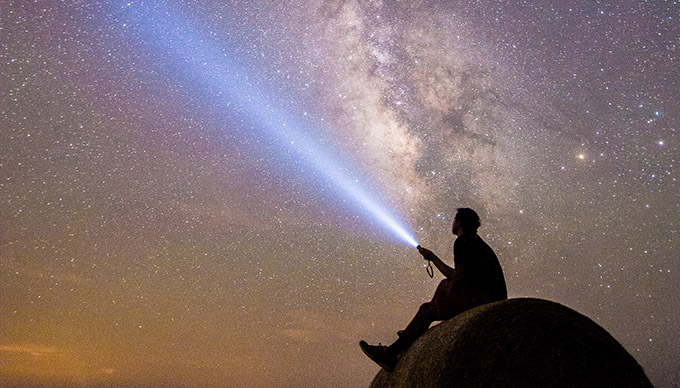The dark skies over the Texas Hill Country create the perfect environment for stargazing. Take a break from the lights of the city and escape to one of these serene locations to gaze at the spectacular night sky views.
Almost every Texas state park offers stargazing opportunities, because they are located away from urban sprawl and light pollution. We included the parks with annual or upcoming stargazing events. Enjoy your stargazing in The Hill Country.
6. Hill Country State Natural Area
Photo: www.beecreekphoto.com
The Hill Country State Natural Area preserves 5,369 acres of the rugged Hill Country landscape in Bandera County, Texas. The goal of this state park is to preserve the natural state of its scenic hills and canyons, so campsites and other facilities are primitive. The park offers 40 miles of multi-use trails for backpacking, primitive camping and horseback riding,
This summer, astronomers from the San Antonio Astronomical Association will bring their telescopes and allow the public to take a peek at the night sky. Visitors may, of course, bring their own scopes and binoculars.
This event is free, but regular park entry fees or annual pass apply.
Photo: blanconews.com
Blanco State Park spans 104.6 acres along a mile of the Blanco River and features camping, swimming, nature trails and a wildlife viewing station.
The park hosts a semi-annual educational event called Stars in the Park. This event offers visitors the opportunity to learn about astronomy and gaze at the stars, planets and galaxies through different telescopes. Volunteers from the Hill Country Astronomers help with the equipment and answer questions.
The springtime event was held in April, and the fall season event usually occurs in November. The events are free with a day entry permit into Blanco State Park.
4. Enchanted Rock State Natural Area
Photo: tpwd.texas.gov
Enchanted Rock is one of the most beautiful and popular hiking and camping spots in Texas. It’s located deep in the Texas Hill Country and boasts the largest pink granite monadnock (isolated rock hill) in the United States.
The skies at Enchanted Rock are dark enough to view the Milky Way, and it is one of only two International Dark Sky Association recognized parks in Texas.
The Enchanted Rock Star Party is an annual event hosted by the Hill Country Astronomers. The event begins as the sun sets, and visitors will see the Moon, Venus, and Jupiter line up. The moon will also cast a shadow across Jupiter’s face, called the Shadow Transit.
The event is free for visitors 12 years old and under and $7 for people age 13 and over. Visitors are encouraged to bring their own telescopes.
Photo: Jonathan Vail
Wimberley is a small Hill Country town located 28 miles southwest of Austin. Stargazers can usually find a free event or isolated spot to sit back, relax and take in the view. The beautiful and mesmerizing night skies in Wimberley are filled constellations and meteors.
Meteor showers, including the Leonids and Lyrids, are visible throughout the year. The amazing Perseid meteor shower reaches its maximum rate of activity just before mid August. Every October, you can get a fantastic view of the Orionid meteor shower as the Earth flies through the debris from Halley’s comet.
If you’re going to set up for an evening of stargazing in Wimberley, bring a few supplies, including comfortable chairs or blankets, bug spray and a red-filtered flashlight.
Photo: tpwd.texas.gov
Inks Lake State Park is located next to Inks Lake on the Colorado River. The park offers an abundance of Hill Country sightseeing, as well as hiking, biking, camping, geocaching and a variety of water activities.
The park periodically hosts a Night Sky Party, and the next one is at the end of May. Visitors can start of the evening with a twilight hike or paddle in the lake. When the sun sets, park staff will then bring out their telescope and laser pointers to show visitors the constellations and planets visible from the park. Visitors are welcome to bring their own telescopes and binoculars.
The event is free with a paid park entry.
1. Lost Maples State Natural Area
Photo: tpwd.texas.gov
Lost Maples State Natural Area is on the upper Sabinal River in the Edwards Plateau, about 70 miles west of San Antonio. It is designated as a natural area, so the focus is on preserving the property’s natural state.
In addition to camping, visitors can use the park’s designated trails to hike, sightsee, bird watch and take photos. It is also one of the best places in the state to see the fall foliage.
Lost Maples State Natural area is hosting a stargazing event this summer. The San Antonio Astronomy Club will be in attendance and bring multiple telescopes to help visitors see the breathtaking beauty of the night sky.








